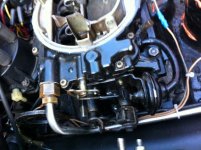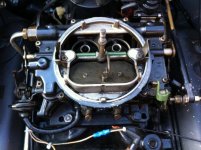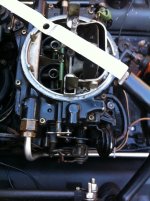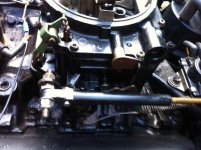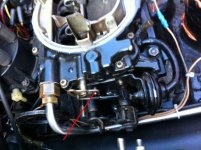Like Rick suggests, I believe you have the coil on the manifold...
see the red line I added to your pic - where does the lower end of the link it is pointing to attach to?
View attachment 7906
Yes this is what he has. The chimney style
bimetal spring choke system. Used for years on auto's........still on marine.
The link arm pointed to is the the link arm going to the bymetal spring that should be eclosed in a metal shell as pictured above in Ricks post # 12 top image.
When cold, if you slightly activate the throttle the choke butterfly should snap shut.
when cranking it and vacuum is created the choke pull off should open the choke butterfly ~ 1/8 inch gap to allow air flow. That is the function of the choke pull off.
Once the motor is up to operating temp the bymetal spring should be completely UNWOUND in your case counter clockwise I believe so the link arm is as high as possible (almost touching the chimney housing) this is ALL the link arm/choke bimetal spring will give you.
There is a balance of how much the link arm can be adjusted (bent) to allow this to happen properly on both sides of the fuction (cold vs warm)
The choke butterfly may not open 100% and may stay closed by as much as ~25 % or so from what I have seen on these carbs.
First thing to to is to bend the link arm to get more opening on the choke butterfly when WARM. Small incriments only.
try to get about 50% more opening than you have now. Once you have accomplished this wait overnight and redo the cold activation, (activate throttle to allow ckoke butterfly to close. It should close shut or almost all the way to all the way shut ~1/16 inch max open would be ok if it does not snap shut still.
then start and let warm up and see where the choke butterfly ends up and let us know.
PS: RICK, most of us use the term bimetal spring. (last 30 plus years)
I for one have never heard of the word HELIX used to describe any choke components. I have heard it used for many other helical devices but not a carb choke system.
Not saying it isnt so, but injecting lesser know/used word to possibly more "acuratley" describe something only confuses.............just sayin.........




